













The founders of Irregardless Café want to build a utopian housing development-meets-community Raleigh | Durham | Chapel Hill







By Chloe Courtney Bohl, p. 10

























































The founders of Irregardless Café want to build a utopian housing development-meets-community Raleigh | Durham | Chapel Hill







By Chloe Courtney Bohl, p. 10

















































5 If you've driven in South Durham lately, you may have seen software engineer Rebecca Murphey staging a solo protest. BY CHASE PELLEGRINI DE PAUR
6 What will it take for Durham to reduce traffic fatalities? BY JUSTIN LAIDLAW
8 An estimated 98 percent of Americans have so-called forever chemicals in their bloodstreams. An NC company has developed technology that can remove and destroy PFAS found in local water supplies. BY JANE PORTER
10 The founders of Irregardless Café are dreaming up a new venture: communal urban living and agriculture. BY CHLOE COURTNEY BOHL
12 A UNC lab was key to developing COVID treatments. It's become central to conspiracy theories about the pandemic's origin. BY MATT HARTMAN
16 Libraries aren't just for books anymore: How Wake County libraries serve as vital lifelines for homeless patrons. BY JASMINE GALLUP
20 The North Carolina Museum of Art's extraordinary new exhibition bears out "an expression of multitudinousness." BY ANDREA RICHARDS
24 Incoming! New movies playing locally in Triangle theaters near you. BY GLENN MCDONALD



3 Backtalk 4 Op-ed
Publisher
John Hurld
Editorial
Editor-in-Chief
Sarah Willets
Raleigh Editor
Jane Porter
Culture Editor
Sarah Edwards
Staff Writers
Lena Geller
Justin Laidlaw
Chase Pellegrini de Paur
Report For America Corps Reporter
Chloe Courtney Bohl
Contributors
Mariana Fabian, Jasmine Gallup, Desmera Gatewood, Tasso Hartzog, Elliott Harrell, Brian Howe, Jordan Lawrence, Elim Lee, Glenn McDonald, Nick McGregor, Gabi Mendick, Cy Neff, Andrea Richards, Barry Yeoman
Copy Editor
Iza Wojciechowska
Creative
Creative Director
Nicole Pajor Moore
Staff Photographer
Angelica Edwards

Advertising
Publisher
John Hurld
Director of Revenue
Mathias Marchington
Director of Operations
Chelsey Koch
Account Representative
Andrew Whiteley
Circulation
Berry Media Group
Membership/ subscriptions
John Hurld
Mathias Marchington
919-666-7229
Last month, Chloe Courtney Bohl wrote about a “bracingly honest” draft strategic plan from GoTriangle. The regional transit agency’s board chair told Chloe after false starts on light rail and commuter rail, GoTriangle is trying to find its footing and pivoting to other modes of transportation like bus rapid transit (BRT). Readers shared their reactions:
I just want to add my feelings of profound disappointment. After decades of life in this region I am once again a commuter along the I-85 corridor with no viable public transit options. This month I put almost 2K miles on my car and burned costly fuel. There are a handful of almost-not-quite/don’t bother public transport options. I am exhausted, perhaps, more than outraged. A regional bus takes me potentially from UNC Hospital to G’boro but won’t stop at hospitals there (where I work). No one system (train or bus) allows for a seamless connection and most require a costly Uber ride at one end. And yet my taxes go up (on car and property) while the can is perpetually kicked down the road on the empty promises of rail transport that other countries have utilized since the last century. Make it make sense.
From Instagram user GOBLIN_BEANS:
The city did a groundbreaking ceremony for BRT in late 2023. It’s 2025 nothing has been even STARTED. This is why there is no trust in our transit: it’s a laughing stock.
From Instagram user PITAA_BREADD:
Until the bus systems easily integrate together into a common MTA it won’t get any better. Often it’s not clear if I have to take a GO Cary, Triangle, Raleigh or Durham bus. None of the systems work together and technically the ticketing is separate for them, leading to confusion on how it all works
Jane Porter reflected on sweet memories with her daughter during the COVID lockdown in a story about the North Carolina Art Museum’s annual Art in Bloom floral festival. Readers enjoyed the lovely piece and beautiful photos, by Angelica Edwards:
:
I remember having blooms that I was going to use to create a piece for Art [in] Bloom and then lockdown happened and we used all those blooms to make random installations around our town! I had totally forgotten about that until you just reminded me. Glad you enjoyed the exhibit. There’s so many amazing pieces this year and thanks for showcasing our [floral installation featured in the exhibit] Moni!
From Bluesky user @PAMLIVENGOODBROWN:
Ultimate #bloomscrolling with the NC Museum of Art.
Finally, Chase Pellegrini de Paur’s piece exploring the authenticity of the Durham accents featured on HBO’s The White Lotus continues to generate reader responses, including a short work submitted for National Poetry Month:
From reader (and Los Angeles-based poet) IVAN SMASON via email:
Parker Posey Poesy
At this advanced age, there is a girl who drives me wild
The prettiest girl I ever dialed
In my dreams, ever so styled
Parker Posey drives me wild
Parker Posey drives me wild
My tears right now are crocodile-d
But missing her is hardly mild
Parker Posey drives me wild
Parker Posey drives me wild
If she’s read this, I hope she smiled My case, in toto, has been filed
Parker Posey drives me wild


A furloughed foreign aid worker says the Trump administration and Republican senators should take a note from Ted Lasso and “be curious, not judgmental” about the real value of USAID spending.
BY KIRSTEN WEEKS backtalk@indyweek.com
I
n a memorable scene from Ted Lasso, the folksy American coach challenges his adversary to a game of darts. As Ted prepares his final throw, he shares a profound insight: “Be curious, not judgmental,” attributing the quote to Walt Whitman. Ted explains that people who belittle others often lack curiosity—they think they have everything figured out, so they judge everything and everyone without asking questions.
What follows is cinematic gold. Ted reveals he played darts every Sunday with his father for six years. With expert precision, he hits his mark and wins the game, demonstrating that judgment without curiosity leads to dangerous underestimation.
This scene resonates with me deeply as I watch the current administration’s approach to USAID, where I’ve worked
on life-saving health programs (including HIV, pandemic threats, and maternal and child health and nutrition) with implementing partners for over 25 years, and done this work from Durham for the past six. The administration seems to be playing darts without asking if anyone else in the room might know how to throw.
The midnight Twitter rants comparing USAID to a “ball of worms” exemplify this judgment-first approach. Ironically, with just a bit more curiosity, they might discover that in vermiculture, a ball of worms actually indicates a healthy ecosystem—much like how USAID creates healthy partnerships globally.
The lack of curiosity has led to embarrassing contradictions. The administration has loudly condemned projects they themselves designed. The Sri Lanka journalism pro-
gram, awarded under Trump’s first term, includes standard journalism training with a single slide on gender-inclusive reporting. Yet it’s been characterized as some radical agenda.
The promised “90-day review” of foreign assistance has been anything but thoughtful. Programs mandated by Congress have stalled despite assurances of waivers. If the administration were curious enough to investigate, they might learn that the “wasteful” economic and governance activities they’ve criticized were designed during Trump’s first term and celebrated as successes under his Prosper Africa Initiative.
With curiosity, they might discover that helping other governments improve their revenue systems creates stability and reduces dependence on foreign aid. They might understand that global monitoring of diseases like avian flu and Ebola protects Americans at home.
If North Carolina’s Republican senators applied Ted Lasso–level curiosity, they’d learn that our state receives the fourth-largest allocation of USAID funds nationwide, creating thousands of local jobs. This might inspire them to stand up for constituents like me—currently furloughed due to reckless funding cuts.
When you’re curious instead of judgmental, you learn that tax dollars spent on foreign assistance return multifold benefits: increased exports, new markets, strategic partnerships, and enhanced national security. You discover that these programs have historically enjoyed strong bipartisan support because they serve America’s interests while helping others.
As Ted would say, “Barbecue sauce.” (That’s Lasso-speak for “mic drop.”)
The administration needs to put down the Twitter megaphone and pick up some questions. Stop the mayhem. Apply curiosity. Use data and evidence instead of assumptions and rush judgments. Senators Budd and Tillis should question the administration’s statements and advocate for their constituents.
In governance, as in darts, it’s better to ask questions before throwing. Because when you assume without investigating, well—you know how that saying ends.
And that’s no way to run a dart game, let alone American foreign policy. W
Kirsten Weeks is a proud Durhamite, UNC-Chapel Hill grad, and global public health leader with over 25 years of experience working with USAID and international donors. Currently navigating a career transition due to the USAID funding stoppage, she remains curious about new opportunities where her expertise in strategic leadership and systems thinking can create meaningful impact.

Software engineer Rebecca Murphey was tired of waiting for Democrats to organize against Trump. So she started protesting by herself on a Durham street corner—and found connection to others in the process.
CHASE PELLEGRINI DE PAUR chase@indyweek.com
Adecade into Donald Trump’s dominance of American politics, liberals are more dejected than ever. In the face of the second Trump administration’s brutal 100-day agenda (see: immigration, freedom of speech, the federal workforce), congressional Democrats’ most visible form of protest has consisted of … holding up little placards at the president’s speech to Congress or, in the case of Triangle representative Valerie Foushee, boycotting the speech altogether.
Rebecca Murphey, a Durham software engineer, does not claim to have figured out a magic solution to stop the administration in its tracks. But she has found a way to at least feel more connected to other people who are trying to resist the administration: For the past month or so, she’s been staging solo demonstrations on a South Durham street corner several days a week.
“I realized that I was waiting for someone else to do something and to tell me to do it too,” Murphey, holding a large TRUMP AND ELON DO NOT CARE ABOUT YOU sign, tells me on a recent weekday afternoon at the intersection of Martin Luther King Jr. Parkway and Hope Valley Road. “The Democrats had months to send us any call to action besides ‘give us money,’ and so I was very frustrated and kind of lost. So I just did it myself.”
Murphey says she doesn’t have a long past as an activist, but she’s always been especially interested in the First Amendment. Other signs of hers have included MY GRANDPA FOUGHT FASCISTS SO I COULD HOLD THIS SIGN and TRUMP TARIFFS RAISE YOUR PRICES.
Murphey says that while she could imagine Durham’s progressive drivers would honk for a FUCK TRUMP! sign, it wouldn’t necessarily feel as constructive. “Part of my
principle is that we will write facts, and we’re not going to call anyone names,” she says. “It’s almost more important that the people who don’t agree read this. This is for the person who thinks maybe Trump is going to save them.”
Other recurring local protests have popped up, most notably at Tesla’s Raleigh showroom. For Murphey it’s more feasible to go to this intersection near her home than to trek to Wake County.
When she’s alone, she’ll sometimes listen to music or a podcast. Mostly, she says, she tries to engage with anyone who wants to, whether they’re giving her a thumbs-up or a middle finger.
On this particular day, she is joined by two other demonstrators, one holding a GOOD PEOPLE, WHAT ARE WE WAITING ON? sign. They both, Murphey says, found her via Bull City Reddit, where she recently posted about her new hobby and put out a call for others to join her. Her post racked up nearly 500 upvotes and over 100 comments. Some locals said that they would be sure to honk and wave next time, and one even offered a delivery of Girl Scout cookies.
As a deluge of cars—I count about 60 in one minute— blow through the intersection, I’m amazed by how many drivers wave or give their horn a little honk of recognition (although it seems some are probably just expressing frustration at other drivers). Murphey says that she’s been surprised by the variety of vehicles whose drivers seem to approve of her signage.
“We get lots of Teslas, we get work trucks, we get school buses, police officers,” she says, adding that it isn’t “just rich liberals in their fancy cars” who honk or wave.
Not everyone, of course, is happy with her. She gets plenty of rude gestures and even had some Twitter trolls sharing her photo around. As we talk, a local property owner shows up to complain about the noise of the honking—which is fair enough, though it’s the middle of the afternoon on a main road and Murphey is on a public sidewalk.
On Reddit, she got some of the usual rude comments and some that questioned the effectiveness of her solo protest—which also seems fair enough. What does she hope passersby take away from her demonstration?
“I hope that they’ll do something, call their congresspeople, join us out on the street corner, talk to their friends and get their friends to realize that what’s happening is not okay. Honking is great. And I hope that they’ll do something to try and act collectively,” she says.
And even though every honk is fleeting, it gives her a small sense of community.
“I do feel a sense that I’m not crazy, I’m not alone. So I wouldn’t say I feel any more optimistic, but I feel more connected to other people.” W

Durham’s Vision Zero coordinator presented recommendations to the city council for eliminating traffic deaths and serious injuries by 2045. Road safety advocates are frustrated with the pace of change.
BY JUSTIN LAIDLAW jlaidlaw@indyweek.com
For residents traveling by foot, bike, scooter, wheelchair, or car, traveling on Durham’s streets can be a perilous pursuit.
But at a city council work session last month, Lauren Grove, the city’s Vision Zero coordinator, presented her recommendations for a Vision Zero Action Plan, a proposal for how the city can confront Durham’s growing traffic violence issue head-on.
From 2019 to 2023, Durham residents suffered 278 serious injuries from crashes, up from 177 the previous five years, and 121 fatalities in the same time frame, up from 97. Black and Hispanic residents are at higher risk, making up 51 percent of the population combined but 68 percent of fatalities.
The city first adopted Vision Zero, a multinational movement to reduce traffic deaths and serious injuries, in 2017.
Vision Zero is akin to the Paris Climate Accords: communities across the world coalesce around a set of guidelines and principles to reduce traffic violence and adopt Vision Zero on their own timeline.
Last year, Durham City Council adopted a new resolution to reinforce its commitment to Vision Zero by including a target date: reduce deaths and serious injuries by 50 percent by 2035, and eliminate them by 2045.
At the March 20 work session, Grove recommended six main policies to help the city meet its goal: update the city’s land use code, create a street design manual, conduct more routine safety assessments, improve streets more rapidly, manage safe speeds, and share traffic safety insights.
Some of these policies are already in motion. Durham’s Planning Department has its hands full rewriting the joint city-county Unified Development Ordinance, the rules that
govern development. Last fall, the city council also adopted the NACTO guidelines, a set of national design standards for transportation networks. The standards brought forth by the Vision Zero Action Plan will be baked into those frameworks to make policies consistent across internal city and county departments as well as external rules that govern private development.
Even with these new standards, for the action plan to be successful, Grove said, the city will need to improve how it tracks and leverages information on crashes and fatalities to measure the effectiveness of different policy interventions and make recommendations that can be acted on swiftly and save lives.
Council member Nate Baker, who encouraged city council to adopt the NACTO standards, called traffic violence a “pandemic that not only doesn’t go away, it gets worse every single year,” during the presentation.
Seventy-four percent of incidents that lead to death or injury happen on streets that make up the city’s “high-injury network,” which accounts for just 10 percent of Durham streets. And just 9 percent of streets in Durham have more than two lanes, but they account for 59 percent of fatal crashes. Without changes to the built environment, speeding and reckless driving are much harder to curb.
“This is why we see so many of the same streets appearing in fatal and serious injury crashes over and over,” Grove said. “These aren’t just random incidents, they’re patterns.”
The Vision Zero team plans to create a public-facing data dashboard for residents to monitor the program’s progress and input incidents themselves. Grove said they also plan to present crash data and other important metrics during
regular updates with the city council.
Advocates like John Tallmadge, executive director at Bike Durham who spoke during the meeting’s public comment period, have been “frustrated with the slow pace of change” on Durham’s streets. Tallmadge said that at the World Day of Remembrance in November 2022, advocates called on city council and staff to do two things: hire a Vision Zero coordinator and create a Vision Zero Action Plan. A year later, the city hired Grove to lead its Vision Zero … vision.
“I believe in a theory of change that to be able to move more quickly on these changes, you need champions on staff, champions
managed by the state, not the city. Council may have more of a spiritual appetite than a financial one for dealing with its two major downtown thoroughfares, even if they are in the high-injury network.
The city transportation department will have to work with its partners at the NC Department of Transportation, which owns and manages a majority of the major roads in Durham’s network, to come up with solutions. The two departments have not always seen eye to eye on how to approach updating state-owned roadways. In the past few years, disagreements have led to project delays, causing some concern about wheth-
“This is why we see so many of the same streets appearing in fatal and serious injury crashes over and over. These aren’t just random incidents, they’re patterns.”
on the elected board, and champions on the outside,” Tallmadge says. “I think we’re at a good time for that.”
At the previous city council work session on March 6, council member Carl Rist suggested that reaching the city’s Vision Zero goals would be nearly impossible without addressing main one-way streets across downtown Durham and beyond: Roxboro and Mangum Streets, and Duke and Gregson Streets.
Transportation Director Sean Egan responded by saying that “there’s a definition of doing the same thing over and over again and expecting a different result. I think it’s difficult to expect a different result unless we make really significant changes to these roadways.”
Newly minted city manager Bo Ferguson said it wasn’t clear, yet, that making the streets two-way is the answer.
“Let’s let the data lead us and certainly we’ll be transparent with what our studies find,” he said.
The Vision Zero Action Plan may have gotten a ringing endorsement from the city council, but in the race for city council budget priorities, two-way conversions ranked slightly below the middle of the pack. The project costs are estimated at around $5.5 million, and Duke and Gregson Streets are

er reaching Vision Zero is possible without a unified vision.
“If we’re not going to do these corridors now, when in the next 20 years are we going to do that if we’re serious about meeting our Vision Zero goals?” says Chris Perelstein, a bike advocate who spoke at the March 20 work session.
Roxboro and Mangum are especially infamous thanks to Perelstein, who created the “Reckless Roxboro” Twitter account to track speeding in front of his home on Roxboro Street using cameras and software he developed. He says that despite the speeding issues that Roxboro continues to suffer from, he isn’t tied to the idea of changing the street to two-way, but instead is focused on supporting the best solution for creating safer streets. The goal, he says, should be to get projects done quickly so that more residents can experience the benefits of a pedestrian-friendly transportation network.
“If you can push the needle on infrastructure, you’re going to start having people experience these environments that are much more pleasant for them to be in,” Perelstein says. “And I think that’s going to drive more buy-in in the future, which then hopefully will get more infrastructure changes. I think that one begets the other.” W


The Town of Cary is partnering with Invicta Water, a North Carolina–based company whose technology has successfully removed and destroyed PFAS in drinking water.
BY JANE PORTER jporter@indyweek.com

In a blue shipping container on the banks of Jordan Lake, foam fractionation units are being deployed in a pilot program that, if successful, could hold the key to cheaply and rapidly eliminating so-called forever chemicals from drinking water sources across the country.
The technology from Invicta Water, a company founded in Burlington in 2023, combines the processes of removing PFAS (per- and polyfluoroalkyl substances) from water and then separately destroying the chemicals onsite.
Invicta Water and the Town of Cary embarked last month on a six-month-long pilot program that will see more than 18 million gallons of water drawn from the lake—one of the Triangle’s main drinking water sources— and treated to remove PFAS, with the chemicals then destroyed. Following that process, the water will be added back to the water supply to be fully treated.
“We’re really looking forward to seeing what the results are,” says Betsy Drake, the water utility engineering manager for the Town of Cary. “The fact that it destroys [PFAS] fast is a very exciting thing, and so we’re really excited to see what it can do.”
PFAS are synthetic chemicals that have been used widely in the manufacturing of household products, including cookware, food packaging, carpeting, and waterproof clothing, since the 1940s. They are characteristically nonsticky and resistant to high and low temperatures and degradation, which makes them difficult to destroy. Because of their widespread use, PFAS have been iden-
tified in water, air, and soil worldwide; an estimated 98 percent of Americans have PFAS in their bloodstreams.
But PFAS pose significant health risks and have been linked to a variety of ailments and conditions including cancer, thyroid disease, liver damage, immune suppression, infertility, and developmental delays. In 2016, the U.S. Environmental Protection Agency (EPA) began regulating levels of three PFAS compounds, including GenX, a toxic chemical found in waterways across Eastern North Carolina that’s linked to the Fayetteville Works site run by DuPont (now Chemours).
In the United States, PFAS are present in 8,865 sites in all 50 states, Washington, D.C., and four territories, according to newly released data from the EPA. The data confirm that 143 million people throughout the country use drinking water that has tested positive for PFAS; dozens of communities in North Carolina, including Raleigh, Durham, Cary, and Chapel Hill, report PFAS contamination of drinking water above the EPA’s limit.
Last year, the EPA required public water systems to complete monitoring for PFAS by 2027 and comply with its stringent limits on PFAS allowed in drinking water by 2029, work that is already under way in the Triangle.
To rid drinking water sources of PFAS, municipal governments are using a variety of treatment technologies. Cary, which has been testing for and treating water for PFAS since 2018, uses powdered activated carbon at its raw water pump station, according to Drake.
“It has shown to be very effective at removing PFAS from the water,” Drake says. “Our testing shows that our treated water is consistently below the proposed EPA limits.”
The method is costly, though, and removing PFAS only solves half the problem; the chemicals still need to be disposed of, which is where Invicta Water comes in.
Steve Wilcenski, the company’s co-founder and CEO, says Invicta Water’s process of removing and destroying PFAS came about in reverse.
Wilcenski and his team began experimenting four years ago with a proprietary material composed of boron nitride. In a magnetic sort of process called adsorption, PFAS chemicals in water stick to the surface of the boron nitride crystals. Then, a UV light is shone onto the crystals, causing a catalytic reaction. The crystals function as a semiconductor and begin to emit electrons; those electrons break up the PFAS and charge the water in a way that also helps break the bonds, leaving behind no harmful byproducts.
But “destroying [PFAS] was only one piece,” Wilcenski says. “We had to figure out how to find it and remove it at the same time. What we like to think that we do is think about things a little bit differently. We’re a small group of people, we don’t have deep pockets. We try to do things ourselves. We wanted to find a better way to do it than the status quo, and we didn’t want to invent anything if we didn’t have to.”

SOURCE: ENVIRONMENTAL WORKING GROUP EWG.ORG
tion cost is $800,000 per year.
Over 10 years, the total cost of Invicta Water’s technology comes out to $48 million, while the total cost of using GAC, at the lowest end, is $120 million; additionally, PFAS are totally destroyed with Invicta’s method, while GAC requires hauling away waste for treatment offsite at additional cost.
Drake says Cary officials found out about Invicta Water’s technology at a virtual presentation that the City of Durham hosted.
“We were intrigued by the technology and also liked the fact that it’s homegrown, so to speak,” Drake says. “Some of their key leadership lives in Cary, so that was a cool thing for us.”
Along with Cary, Invicta Water is conducting pilot projects with municipalities, manufacturers, and other customers across the Southeast, including the City of Burlington, and Spartanburg and Laurens Counties in South Carolina.
tory at UNC-Chapel Hill to show it can use its process to remediate ponds with extremely high levels of PFAS contamination, something that will be helpful for landowners who want to redevelop contaminated property. And the company is partnering with NC State University and Duke University, comparing lab results to see “if [the universities’] techniques can help improve the accuracy, the precision, and the speed to get data.”
“That’s also a big problem with PFAS,” Wilcenski says, “just how long it takes to get the data.”
So they looked to foam fractionation, technology that’s used in aquaculture, fish farms, and large aquariums. Foam fractionation uses water bubbles—air mixed with water—to bind to the broken-up PFAS chemical molecules and pull the contaminants directly out of the water.
“We figured out [a] way to put a few of these foam fractionators together in a very special manner … that we can find even the smallest molecules,” Wilcenski says. It’s a process that’s patent pending.
The final step was to build out the technology in a way that’s scalable. They came up with a box that pipes in untreated water, runs it through the system, separates clean water from PFAS-contaminated water (that’s now a smaller volume with a much higher concentration of PFAS), and breaks the PFAS down. A version of this box will treat 100,000 gallons of water each day at Jordan Lake through September.
“And all of this is done using very, very little energy, a very small footprint,” Wilcenski says. “And it’s very inexpensive compared to everything else that’s out there.”
Invicta Water’s technology has two cost advantages, Wilcenski explains: upfront costs and annual operation costs. While the most common PFAS removal technology that’s currently in use, granular activated carbon (GAC), typically costs $2-$4 per gallon of water, Invicta Water’s solution costs $1-$1.50 per gallon.
For Cary’s plant, which treats some
40 million gallons of water per day, that would mean a savings of between $40 million and $100 million per gallon.
Wilcenski says the annual operation cost for GAC is about 5 to 10 percent of the upfront cost, or for Cary, some $4 to $8 million per year in perpetuity. At the highest end, Invicta Water’s annual opera-
A recent pilot using drinking water from Pittsboro showed a 100 percent reduction in three PFAS compounds after treatment. Another pilot with the City of Raleigh showed a 100 percent reduction of four PFAS compounds in reverse-osmosis-treated wastewater. And a pilot in Wake Forest using industrial wastewater showed a 99.7 percent reduction in the PFOA forever chemical compound and 100 percent reductions in two other PFAS compounds.
Wilcenski says Invicta Water is also working on a project with the Collabora-
Soon, Invicta Water may be able operate at both the micro and macro scales, Wilcenski says, treating millions of gallons of municipal drinking water each day all the way down to having small systems operating in people’s homes. The prototype for a home system is expected to launch this summer and could be a game changer for people living in communities that can’t afford to treat their drinking water.
“We’re gonna have something that you can put in your house, probably … about the size of a water heater is what we envision,” Wilcenski says. Those, too, will operate cheaply and efficiently.
“All we’re really using is a little bit of electricity, air, water, and essentially gravity to do most of the work,” Wilcenski says. “There’s almost no cost to do the destruction. And because we’re completely destroying everything, there’s also no waste to dispose [of].” W


Arthur and Anya Gordon, the founders of Irregardless Café, want to turn their southwest Raleigh community garden into affordable housing.
BY CHLOE COURTNEY BOHL chloe@indyweek.com
Arthur and Anya Gordon, the founders and former owners of the iconic West Morgan Street restaurant Irregardless Café, are pursuing a new venture: an affordable, multigenerational housing development connected to their community garden in southwest Raleigh.
The Gordons own about 2.5 acres located across the street from Athens Drive Magnet High School that’s currently home to their Well Fed Community Garden. There, they work with a local farmer to grow vegetables, fruits, and herbs, raise chickens, and keep bees. They bought the land at a foreclosure sale in 2012 intending to grow fresh produce for Irregardless, Arthur says, and did so for years. Since selling the restaurant in 2020, they’ve been think-
ing about other purposes the garden property could serve.
The couple envision a three-story apartment building with older residents living on the first floor, families on the second, and dormitory-style or cohousing on the third.
A street-level bodega could sell premade meals and fresh produce to neighbors and nearby high schoolers. Residents would be responsible for cultivating the garden, which would continue to exist on a smaller footprint.
Standing between the Gordons and their dream of communal urban living and agriculture is Raleigh’s Unified Development Ordinance, which currently permits only lowscale development of houses or duplexes on their property. The Gordons are petitioning the Raleigh Planning Commission to rezone the land to allow for residential mixed-use development, which would enable them to build a three-story apartment building with 67 units and retail space on the ground floor.
At the planning commission’s March 11 meeting, Arthur invoked his track record of bringing out-of-the-box ideas like Irregardless to life in Raleigh.
“Nothing else like [this proposal] exists” in Raleigh, he acknowledged, “but there were no nonsmoking vegetarian restaurants 50 years ago as well, and today it’s considered part of the establishment.”
The commissioners, along with a few neighbors who spoke in opposition to the Gordons’ request at the meeting, seemed most concerned about the wide range of retail uses permitted by residential mixed-use zoning.
“This land could be … sold to a developer and we could wind up with a vape shop or a convenience store,” said one neighbor who spoke in opposition, suggesting that the land should be used as the new location of the Athens Drive Community Library instead.
Some neighbors also expressed worries about the stormwater implications of redeveloping the Gordons’ property, since the neighborhood’s stormwater system is already “at capacity.” But Arthur says the development he’s proposing would capture stormwater rather than exacerbating runoff.
“There’s going to continue to be a farm on the property, so we want the water,” he says. “We don’t want to make it impervious and have it run off. We want to put in retaining ponds.”
The planning commission seemed open to the Gordons’ idea but asked Arthur to come back on April 8 with more conditions attached to the rezoning request—addressing things like height, noise, and lighting restrictions and prohibitions on certain commercial uses.
If the Gordons’ proposal receives approval from the planning commission and then the city council, Arthur says their next step would be to sell the property to a nonprofit developer who agrees to develop it according to their specifications. He and Anya are still looking for the right partner.
“We have talked to a number of nonprofits … who said to us, ‘Go through the process, see if you can get this rezoned, and if you can, then come back and talk to us,’” Arthur told the planning commission.
The couple is ready and willing to plow through layers
“The idea is, the two big issues that seem to be hurting our culture right now are affordable housing and mental health,” Arthur Gordon says. “What I’m pushing for is that the people who end up living on the property have to do something with the garden. They can water the flowers, they can turn the compost … and in return, they get a reduced rent.”
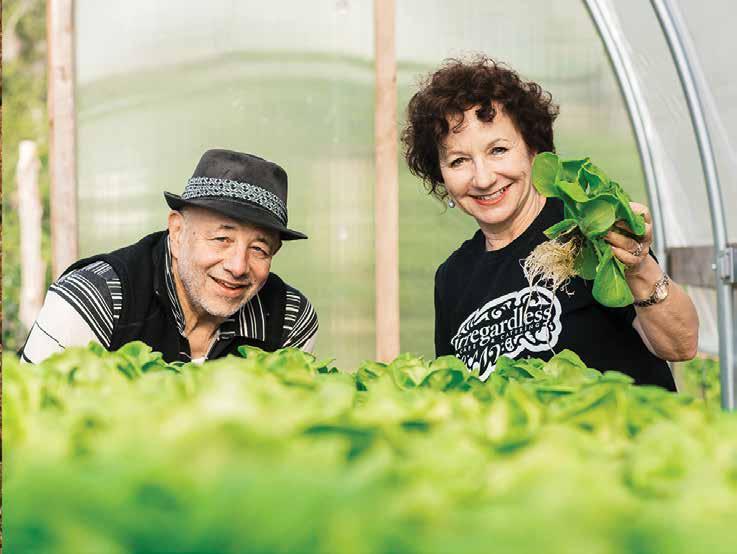
of bureaucracy and negotiation to get this project done the right way.
“If you wait long enough, anything can happen,” Arthur says,
At 75, the chemistry and philosophy double major turned chef turned part-time high school culinary teacher is eccentric and serene. Over coffee, he regales me with stories from his restaurant days, reflections on the meaning of dreams, and instructions for preparing egg salad. His raison d’être as a business owner and
human being, he explains, is creating community in a world that increasingly prioritizes isolation and greed.
The redevelopment plan might evolve, he says. He and Anya aren’t categorically opposed to the idea of putting a library on the property, if they determine that to be its “higher purpose.” Their primary goal is to create something that fosters healthy connection.
“This is more than a rezoning,” Arthur says. W



Public health leaders looked to UNC virologist Ralph Baric to end the pandemic. Their critics blamed it on him. Now, the White House wants to slash funding for research like his.
BY MATT HARTMAN matt@theassemblync.com

The Baric Lab doesn’t look like much from the outside. Certainly not like a central node in a once-in-a-generation global event.
At one of his laboratories, tucked away in a Gillings School of Public Health building on the UNC-Chapel Hill campus, the only sign is taped to the window near a notice about the trash collection schedule. A nameplate nearby is blank, minus a bumper sticker for the unincorporated community of Little Switzerland, a postcard, and a sticker of a bat just below.
Over spring break, almost five years to the day after North Carolina’s first COVID-19 shutdowns began, the hallway outside was mostly abandoned to cardboard and styrofoam boxes that once held supplies now distributed across the labs.
Humble as it may seem, this lab and its principal investigator, Ralph Baric, are central to the story of COVID-19—as well as the distrust of science that has grown in its wake. As federal research funding becomes a central issue of the Donald Trump administration, there may not be a more important, nor disputed, test case in the country.
Perhaps the world’s foremost expert on coronaviruses, Baric and his collaborators helped roll out the first FDA-approved COVID-19 treatment, the existing antiviral Remdesivir, then helped develop another, Molnupiravir. Then Baric helped develop and test the Moderna vaccine. (It was spearheaded by Kizzmekia Corbett-Helaire, a Hillsborough native and one of Baric’s former Ph.D. students.)
The work earned him global praise, as well the North Carolina Award, the state’s highest civilian honor, and the University of North Carolina System’s O. Max Gardner Award,
given to faculty who have “made the greatest contribution to the welfare of the human race.”
But it also brought intense scrutiny and placed Baric’s lab at the center of global investigations and congressional testimony about the origins of COVID-19, as well as conspiracy theories about the lab’s role in the pandemic.
Last year, a House Select Committee investigating COVID-19’s origins deposed Baric on his research. At a Senate hearing on National Institutes of Health funding in China, Sen. Rand Paul accused him of working with the Wuhan Institute of Virology to create “superviruses.” Robert Redfield, director of the Centers for Disease Control and Prevention when the pandemic began, told podcaster Dana Parish that “there is a real possibility that the virus’s birthplace was Chapel Hill,” calling Baric “the scientific mastermind” behind it.
Now, multiple bills have been introduced in Congress that would likely ban the genetic engineering research Baric is known for. Another would prevent research contracts with labs in “countries of concern” like China, where Baric collaborated with the Wuhan Institute of Virology for years.
Meanwhile, the Trump administration is seeking to slash NIH funding for research. Baric’s lab is one of North Carolina’s largest recipients of such funding. He’s brought in millions from the NIH over his career, including a $65 million grant in 2022. A report in The Atlantic suggested that research into mRNA vaccines, like the Moderna one Baric supported, could be targeted for cuts.
The outcome of those policy debates won’t just shape Baric’s lab. They will shape North Carolina’s biomedical industry and how the world prepares for future pandemics.
Baric and UNC-CH’s public health school declined to comment for this story. But he warned in his House deposition last year that cracking down on science could have consequences for U.S. competitiveness.
“There has to be some refinement and consideration for the long-term impact of those regulations on scientific leadership, our economy, the biosecurity field, the biosafety fields, and entrepreneurship, innovation, and discovery,” Baric said. “And if you close all that down, microbiology is gone to China, and they have a 10-year plan to be No. 1, and we’re helping them.”
Baric, 70, was raised in New Jersey but moved to North Carolina in 1972 when he accepted a full scholarship to join the North Carolina State University swim team. His CV still lists his Atlantic Coast Conference championship and records in five events.
He graduated with a zoology degree, then stayed in Raleigh to complete his Ph.D. in microbiology at N.C. State. After a postdoctoral program in California, Baric joined the UNC-Chapel Hill faculty in 1986. He’s been there ever since.
Baric was happy to spend his career in the “scientific backwater” of coronavirus research, epidemiologist and science writer Dan Werb wrote in a 2023 Time profile. “Far from the glare of public opinion, Baric could work at his own pace,” Werb wrote.
The topic became less of a backwater when the SARS
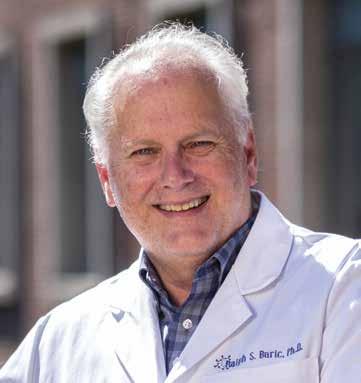
epidemic hit China in 2003, then again when MERS caused another epidemic in the Middle East in 2012. Both diseases are caused by coronaviruses.
A few years later, Baric began to sound the alarm about the threat of a global coronavirus pandemic. He had already discovered that the virus family was able to mutate and jump between species, so he began looking at whether some strains present in bats and other animals might soon be able to infect humans. The result was a 2015 paper in Nature arguing that a “SARS-like cluster of circulating bat coronaviruses shows potential for human emergence.”
To prove the point, Baric pushed the genetic engineering of viruses forward. For the Nature paper, Baric took the genetic code that enables some coronaviruses to infect humans—the spike protein—and spliced it into strains that didn’t have it. When the resulting viruses, called chimeras, infected human cells, Baric had proof that there was a pool of coronaviruses that were only one mutation away from jumping to humans and creating a deadly outbreak. That strategy was immediately controversial. Baric’s work is often described as “gain-of-function” research. The precise meaning of the term is widely contested, but generally it means altering organisms to give them abilities they don’t have in nature, like engineering them to grow faster or become more contagious
Baric has said that the study didn’t qualify as gain-of-function research under NIH definitions, but other scientists still felt the benefits weren’t worth the risks of creating a potential pandemic pathogen. “If the virus escaped, nobody could predict the trajectory,” virologist Simon Wain-Hobson told Nature at the time.
Baric disagreed. In his congressional deposition last year, he argued that not
“No chance it’s even close.”
—Ralph Baric, on the odds the pandemic was caused by natural mutation
making drug and vaccine candidates look more effective than they would actually be in humans. Engineering a stronger version of the virus may allow for more accurate testing.
“I would ask critics if they had identified any broad-spectrum coronavirus drugs prior to the pandemic” like his lab did, Baric told MIT Technology Review. “Can they point to papers from their laboratories documenting a strategic approach to develop effective pan-coronavirus drugs that turned out to be effective against an unknown emerging pandemic virus?”
only is gain-of-function research, broadly defined, necessary to understand emerging viral threats, but also to develop drugs to combat them. Because viruses often weaken when they jump across species, they can be less virulent in lab mice than in humans,
As soon as evidence of a concerning new respiratory disease emerged in late 2019, global health leaders reached out to Baric. He was part of the group that named the virus that causes COVID-19, now officially referred to as severe acute respiratory syndrome coronavirus 2, or SARS-CoV-2. In
February 2020, he met with Anthony Fauci, then director of National Institute of Allergy and Infectious Diseases and the head of the United States’ COVID-19 response, to discuss “the outbreak and chimeras,” according to one of his collaborators. When Duane Caneva, the Department of Homeland Security’s chief medical officer, added Baric to an email thread where national experts discussed the emerging crisis, he wrote, “It does contain some attempts at humor, so, for example Ralph, don’t be surprised to references that you belong on the Mt Rushmore of Coronavirus experts.”
“I luv humor,” Baric responded. Initial reports stated that the virus originated in a wet market selling live animals in Wuhan, China. But concerns were increasing among some scientists and U.S. officials that COVID-19 may have leaked from a virological research lab—possibly the Wuhan Institute of Virology. Zhengli-Li Shi, a researcher there, was a coauthor with Baric of the 2015 Nature
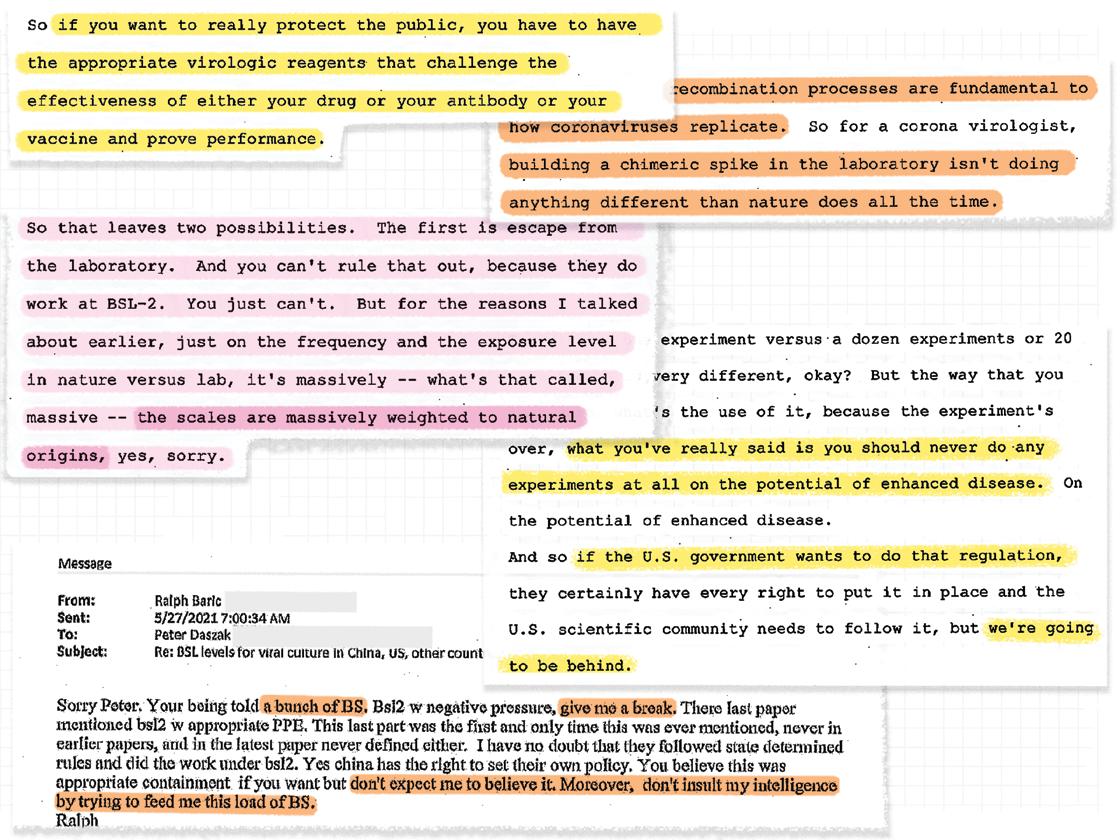
Ralph Baric defended his research in a House deposition. In emails, he criticized Chinese scientists’ safety protocols.
“If the virus escaped, nobody could predict the trajectory.”
—virologist Simon Wain-Hobson, criticizing Baric’s research in Nature in 2015
paper. She and Baric had also collaborated on a 2018 grant proposal to the Defense Advanced Research Projects Agency for studies on the specific genetic element making SARS-Cov-2 so infectious.
Though the proposal was denied, and both Baric and the principal investigator, Peter Daszak, said the research was never completed, its existence fueled debate. “This definitely tips the scales for me” toward the
likelihood that COVID-19 leaked from a lab, the biologist Alina Chan told The Intercept. “And I think it should do that for many other scientists too.”
Baric is notoriously rigorous with biosafety measures—“I kind of set the standard in the United States,” he said in his deposition—equipping his most secure labs with two fans with redundant power systems to ensure no air flow in or out, handling
viruses in specialized cabinets with back-up battery power, and requiring staff to wear full body suits with double gloves, hoods, and shields with pumps moving air through filters. The Wuhan lab operated with fewer precautions, as outlined in their published papers and internal discussions.
Baric noted the different safety levels at the time of the proposal, and complained about it in a 2021 email to Daszak. “You believe this was appropriate containment if you want but don’t expect me to believe it,” he wrote to Daszak.
Some people who think a lab leak might have caused the pandemic, like sociologist (and former UNC-Chapel Hill faculty member) Zeynep Tufekci, look at Baric as a voice of reason pushing for better safety precautions. Others, like Richard Ebright, a molecular biologist and founder of the anti-gain-of-function advocacy group Biosafety Now!, claim Baric knew the Wuhan lab was the source of the outbreak and kept it from the public. The Central Intelligence Agency, Federal Bureau of Investigation, and Department of Energy have now all concluded a lab leak is the likely cause of the pandemic, albeit with differing confidence levels.

Scrutiny of Baric’s research has also birthed some baseless theories that COVID-19 was purposefully released as a bioweapon or as a way to profit from the drugs that helped end the pandemic. Those led to death threats that forced the Baric lab to tighten security in 2023. He has largely stayed out of the spotlight since.
The Assembly contacted more than a dozen current and former researchers from his lab. None agreed to speak.
“We absolutely abhor any threats of violence against Ralph Baric or his lab or any other scientists across the world,” Gary Ruskin, executive director of U.S. Right to Know, a nonprofit that says it uncovers government public-health failures, told The Assembly. “At the same time, the University of North Carolina owes the public some answers.”
Ruskin has obtained tens of thousands of pages of emails, chat records, and other communications from Baric and other researchers, but UNC-Chapel Hill denied a request for additional communications between Baric and the Wuhan Institute of Virology, citing a university research exemption from public records laws. U.S. Right to Know has sued the university; the case is currently at the N.C. Court of Appeals.
“UNC-Chapel Hill takes its commitment to transparency and compliance with public records laws seriously and, accordingly, has produced more than 130,000 pages of records in response to US Right to Know requests included in the lawsuit,” a university spokesperson said in a statement.
Baric, meanwhile, has said publicly that a lab leak was possible, and signed a 2021 letter in Science urging a full investigation of COVID-19’s origins. “You can’t rule that out,” he said in his deposition last year.
But he also said the odds that a natural mutation caused the pandemic were much greater: “No chance it’s even close.”
One of Baric’s loudest critics is new Health and Human Services Secretary Robert F. Kennedy Jr. In his 2023 book The Wuhan Cover-Up And the Terrifying Bioweapons Arms Race, Kennedy claimed that “twenty years of gain-of-function deviltries have yielded virtually nothing useful to humanity,” and called Baric “the archetype for how the Chinese maneuver US government-funded scientists into transferring bioweapons technology to the Chinese military.”
While running for president in 2024, Kennedy also suggested an eight-year
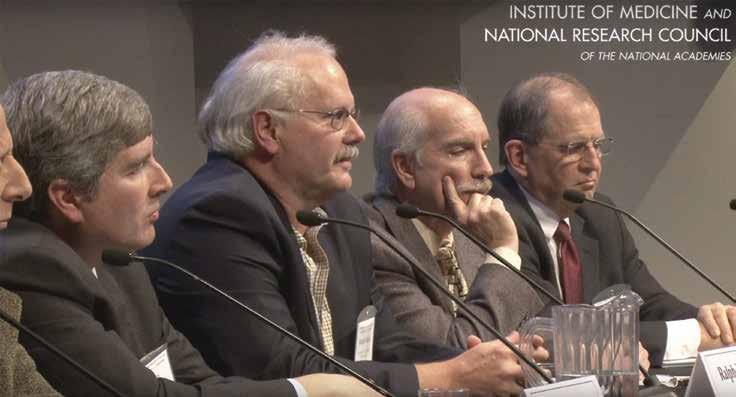
“break” from NIH funding of infectious disease research, prioritizing chronic illnesses like obesity and diabetes instead. Since the noted vaccine skeptic has taken office, scientists have been told to remove any references to mRNA vaccines from NIH grant proposals, KFF Health News reported.
Congress hasn’t passed new restrictions, but policy changes under Trump and Kennedy are already slowing scientific research. Universities have long used government funding, especially from the NIH, to offset the enormous cost of their research. “It’s one of the reasons why both our science and technology and our research universities are the envy of the world,” said Chris Beyrer, director of Duke’s Global Health Institute.
But the Trump administration has made clear it hopes to change that model. The administration has sought to cap so-called indirect costs—reimbursement for overhead expenses, such as the biosafety measures that Baric relies on—at 15 percent, much lower than universities have negotiated in the past. University wide, UNC-Chapel Hill’s indirect cost rate is currently 55 percent.
Though courts have blocked Trump’s attempt to pause most federal grants, science funding is still functionally frozen.
Beyrer has had NIH funding for the entirety of his 33-year career, he said, but “right now some of that funding is on pause and we don’t know when it’s going to be approved.” The only money he knows of coming out of the NIH are one-year renewals of previously awarded multi-year grants.
At the same time, other countries are building out their own biopharmaceutical research and development industries to avoid the shortages they faced in the pandemic.
“What happened in so many other countries was that there was no vaccine available,” Beyrer said. “The model that devel-
oped was essentially charity—people giving leftover vaccines, people donating vaccines that they didn’t want to use.”
Shifting such research out of the U.S. is a risk, in Baric’s eyes, in part because of the lack of international regulations over biosafety.
In a recent New York Times op-ed coauthored with Columbia University epidemiologist Ian Lipkin, Baric lambasted his former Wuhan collaborator, Shi, for continuing to do research with the same reduced biosafety measures that launched worries of a lab leak.
“This work was apparently approved by the local institutional biosafety committee and adhered to national biosafety standards,” Baric and Lipkin wrote. “But it is not sufficient for work with a new virus that could have significant risks for people worldwide.”
Baric and Lipkin called for global standards around biosafety, pointing to the World Health Organization as the de facto leader. But the Trump administration pulled the United States out of the WHO, limiting its ability to influence any such effort.
U.S. funders could also place biosafety requirements on their international partners, but growing antagonism between the U.S. and China has curtailed such cooperation. The proposed DETERRENT Act would prevent U.S. researchers from signing contracts with Chinese institutions. China already imposed similar limits on its scientists in response to earlier U.S. legislative proposals, as well as the prosecution of Chinese scientists and professors accused of spying.
“It has now become all but impossible to get a collaborative research grant funded by any branch of the federal government approved in China,” Beyrer said. “There’s no question that is really a big change, and many of us perceive it to be a significant loss.”
“Wouldn’t the world have been a different place if we had Paxlovid when COVID emerged?”
—James Rosen
Despite all of the pressure on scientific research, the CEO of one Triangle-based company said he is hopeful about the future of biopharmaceutical innovation. James Rosen leads the Rapidly Emerging Antiviral Drug Development Initiative, or READDI, which is a public-private partnership and an “affiliated entity” of UNC-Chapel Hill. Baric helped found it, and the $65 million NIH grant he received in 2022 went to a center that is part of READDI. The General Assembly also gave READDI $18 million in 2022.
There are 24 families of viruses that cause human illness, Rosen explained, and eight of them have the potential to cause another pandemic, including coronaviruses, flaviviruses (like Dengue and Zika), and filoviruses (like Ebola and Marburg). READDI is trying to develop two broad-spectrum, small-molecule antiviral drugs for each. Rosen said READDI doesn’t do cutting-edge work like mRNA vaccines or gain-of-function research.
“Just a good old-fashioned blister pack of pills,” Rosen said. “What we tell people to think about is: Wouldn’t the world have been a different place if we had Paxlovid when COVID emerged?”
But a great deal of science has to happen before biopharmaceutical companies will step in, Rosen said. The parts of a virus that drugs could effectively target have to be identified, as do the patentable molecules that can target them without causing unwanted interactions elsewhere. Until that work is done, the financial risk is too high for companies to bother.
That’s why university officials, scientists, and others are concerned by the Trump administration’s moves to restrict funding for research.
A Duke University study found that the likelihood of a COVID-19-level pandemic is
about 2 percent in any given year, meaning another is statistically likely to occur within the next 60 years.
A strain of bird flu, H5N1, has been spreading across the globe. It’s already caused a pandemic in wild birds, even hitting those on remote islands, Beyrer said. It infected chickens, and then jumped to cattle—a mammal that “doesn’t typically get bird flu,” Beyrer pointed out. There have already been human cases, though mostly mild. But earlier this year, the virus jumped again, this time to cats, where it has proven much more lethal.
A UNC-CH spokesperson said the school doesn’t conduct gain-of-function research “as it is defined under current laws and regulations,” and the university will adjust as needed if those rules change.
UNC-Chapel Hill lobbyist Kelly Dockham said she believes that Baric’s work studying viruses will continue to receive support, in part because of what she said was strong backing within the state.
Dockham said she’s spoken with legislators over the past several years about the need for better antivirals. Former Sen. Richard Burr, now a lobbyist for UNC-Chapel Hill and Duke, championed multiple pandemic preparedness initiatives while in office, and current Sen. Thom Tillis has pushed for increased NIH funding over the last two Congresses.
Tillis “is very uniquely positioned and aware of the significance that this money provides for the entire state,” Dockham told The Assembly
“I am optimistic,” she added. “Now, maybe am I too Pollyannaish? I don’t know, but I just know that the conversations that I’m having in my professional capacity, it gives me motivation and hope.” W
Erin Gretzinger contributed additional reporting.

Libraries aren’t just for books anymore. In Wake County, these accessible public spaces are also vital lifelines for homeless patrons.
BY JASMINE GALLUP backtalk@indyweek.com
At 8:30 a.m., a heavyset man stands outside Richard B. Harrison Library waiting for the glass doors to open. It’s frigid, a near-freezing day, but John is prepared.
“You got to have these,” he says, cheerfully pulling out a pair of mittens stashed in the pocket of his hoodie. “And don’t forget these,” he adds, pulling up the hem of his jeans to show off long johns. The outfit is topped with a bright orange-and-blue beanie.
John’s already been standing in the cold for about 45 minutes after dropping off his phone at a nearby barbershop to charge. If he manages to scrounge up a couple of dollars, he’ll get himself a Black and Mild before settling down in front of one of the library’s computers to look for a job, he says.
“I’m not an entry-level person, I have certain skills,” he says. “My main thing is warehouse operations, like Amazon, DHL. I’m supervisor material.”
In addition to looking for a job and building his résumé, John is also looking for nonprofits that help pay rent and utilities, he says.
It’s not unusual for people in need, especially those who are unhoused, to show up at the library in the early hours.
Richard B. Harrison and Oberlin Regional, the two biggest libraries in downtown Raleigh, are warm, clean spaces where people experiencing homelessness can linger without consequence.
Living with homelessness can be chaotic, loud, and trau-
matizing, says Kathy Johnson, executive director of local nonprofit Oak City Cares. The library is a “safe, quiet space” where people can access the internet to connect with family or look for jobs. It also offers time alone, Johnson adds.
“We all take for granted that when you just don’t want to be around people, you go to your room, and you close the door,” she says. “Libraries can provide some of that solitude and space for people.”
On the open, bright second floor of Oberlin Regional, people from all walks of life are sitting quietly—some reading, some working, and some just being.
In one corner, a man in a gray beanie silently bops along to the music in his earbuds as he plays online chess. Across the floor, at a white desk, a young woman with long red hair types rapidly on a laptop.
Meanwhile, Rob and his friend—a woman bundled up in layers of fleece sitting next to a metal walker—are “just chilling,” he says. They come here nearly every day, mostly to stay out of the cold or inclement weather. On this Feb-
ruary morning, the sky is gray, and rain has been drizzling down for the last few hours.
“Her and I don’t have nowhere to go,” Rob says. “It’s somewhere to stay dry.”
Across the country, homelessness is surging. From 2023 to 2024, the number of people experiencing homelessness increased by 18 percent, according to the U.S. Department of Housing and Urban Development.
Numbers in Raleigh mirror that trend, Johnson affirms. In 2024, Oak City Cares served about 6,000 people, four times the number it served in 2022 (about 1,500). During Wake County’s annual Point in Time Count last January, volunteers spoke with 992 people who were unsheltered during the night, providing a snapshot of the extent of homelessness in and outside of Raleigh. Data from this year’s count is not available yet.
The wealth gap in North Carolina (and across the United States) is on the minds of many, including John. In early February, he’s troubled by the news of recent union battles between local Amazon workers and leadership.
“They [the Amazon workers] are already on strike,” he says. “Jeff Bezos don’t want to pay them, and he got all them billions of dollars. And got money still coming in hand over fist.
“Him and Elon Musk,” John continues. “This guy’s almost worth almost $500 billion. Can you imagine just waking up in the morning, your house is as big as this library, you got three, four private jets? That’s a whole lot for one person.”
On the other end of the oligarch spectrum are people at risk of eviction or experiencing homelessness. During the week, Oak City Cares acts as a hub where people can come to fulfill their “basic needs,” like doing laundry, taking a shower, or picking up mail.
While libraries can’t provide all the services the nonprofit
“You have to triage every different person. People will come in with a need, and the ability to articulate that need is not as intuitive as you may think it is.”
does, they do have public computers and areas where people can charge their cell phones.
“It’s another one of those things that you might take for granted if you aren’t really familiar with experiencing homelessness—but your cell phone is your lifeline,” says Johsnon. “And being able to charge it really is important.”
Equally important is the fact that in a city where resources are limited, public libraries are numerous and usually easily accessible. Richard B. Harrison has a bus stop right outside its main entrance, and Oberlin Regional is also near a bus stop on Route 16.
“We are an urban branch, and we have all the rewards and challenges that entails,” says Robert Lambert, manager of Oberlin Regional. “We have six universities in our service area, and we have at least as many shelters.”

“We’ll
This year, in a major step forward, social workers in training have the option to embed in various libraries as part of a UNC Pembroke internship program, says deputy library director Ann Burlingame. She’s hoping that the initiative, if the libraries are chosen by interns, may boost the library’s efforts to connect people to resources, including government aid programs that can be complicated to navigate. While the main drivers of homelessness are the cost and availability of housing—not mental illness or addiction— there is still some overlap. Experiencing homelessness can worsen mental health, lead to substance abuse, and distance people from necessary care. Social workers could help librarians develop the skills they need to help or to de-escalate disruptive behavior.
In 2024, Raleigh police responded to 17 calls for service inside Oberlin Regional Library, including for welfare checks, general assistance, disturbances, threats, and trespassing— which the library only resorts to after repeated offenses, says Lambert.
If someone is violating the library’s policy against “excessive or disruptive noise or behavior,” they may be asked to leave, he adds. Likewise, if someone is clearly inebriated or under the influence of drugs, they will be escorted out.
“If somebody has been drinking and just won’t stop talking to people, I’ll ask them to leave,” Lambert says. “Come back tomorrow. We’ll try it again. If they come back and it’s a continual chronic issue, then we may move to a trespass.”
A trespass charge means a ban of one year, although the decision can be appealed, Lambert says. Often, if the ban is related to alcohol addiction, “people get themselves
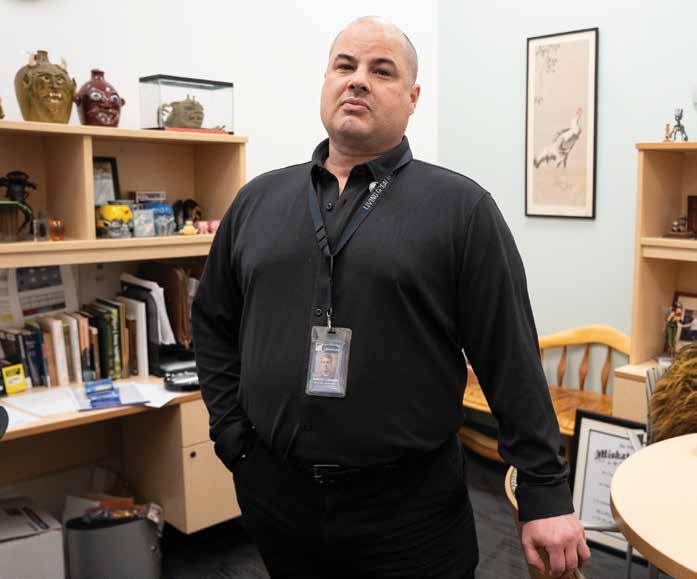
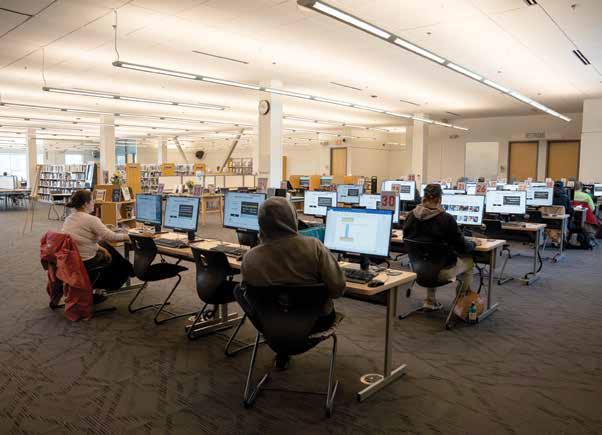
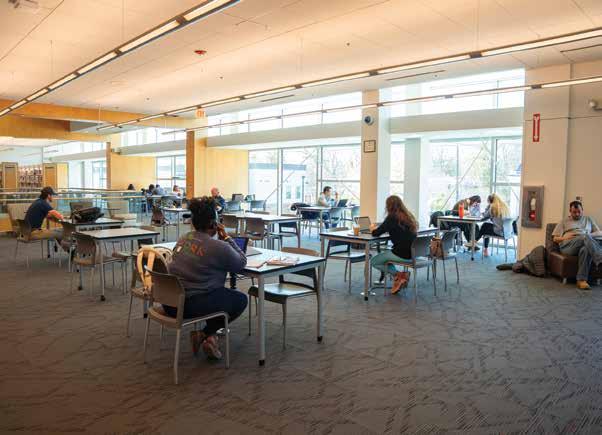
together and they get a second chance,” Lambert says. “I’ve seen that time and time again. There are people who will probably be in today, who I know, who are sober now.”
The library also bans smoking, vaping, and the “misuse of restrooms, including use for personal bathing and grooming,” and requires “appropriate dress, including shoes and shirt.” But none of these rules apply only to a specific population, Lambert says.
“There are people who are homeless who want a place to sit and eat. And we can do a lot, but we’re not a cafeteria,” he says. “But it applies equally to the high schooler who just came from Chick-fil-A.”
Still, some of these rules may disproportionately affect people experiencing homelessness, like the ban on sleeping. Library staff are not equipped to run a day shelter, but it’s also difficult to turn away someone who only got a few hours of sleep on the sidewalk last night. Sitting at Oberlin Regional, Rob says that one of his responsibilities is to keep his friend awake.
“She stayed at the food hall overnight. They let her sit there last night ’cause of the weather,” he says. “I was a block away from her. I have a tarp with me, so I covered myself with the tarp and that was that.”
There has to be a balance between public access and security, says Burlingame. Security officers from Allied Universal are stationed at Oberlin Regional and Richard B. Harrison Libraries, but the effort is to build relationships, not crack down on behavior.
Social workers may also help bridge that gap, Burlingame adds, “so we don’t just assume that the way to handle this situation is to call security.” While there’s still progress to be made, Wake County libraries have done a great job of working with people experiencing homelessness, says Johnson, speaking from an outside perspective.
“When you’re unhoused, there can be a lot of shame and distrust. You really don’t want to share with everybody what is going on and your situation. There’s a lot of judgment,” says Johnson. “In Wake County, they’ve been fantastic.”
Librarians are often the first point of contact for people who come in looking for help, whether it’s to find a book or a place to sleep. When a staff member is on the front desk, they essentially act as an “emergency room nurse,” says Lambert.
“You have to triage every different person. People will come in with a need, and the ability to articulate that need is not as intuitive as you may think it is,” he says.
“We listen to the person first, and we may ask clarifying questions so that we know the answer we’re providing them is actually addressing the need they have—which is not always the same as whatever it is they just expressed.”
There’s no one script, just like there’s no one type of person who comes into the library, says Lambert. Everyone comes from different circumstances, including experiences of homelessness.
“We are trained not to make assumptions,” Lambert says. “So before we actually listen to people, we have to withdraw our own biases so that we’re capable of hearing them. So we’re not imposing our own world view onto the person in front of us.”
In recent years, Wake County library managers also received additional training on how to help people dealing with housing insecurity, says Burlingame. Librarians toured Oak City Cares and heard about the experiences of people dealing with homelessness and the volunteers who help them on a day-to-day basis.
“The thing that they [the county] taught us is to focus on the person, not on their situation,” says Burlingame. “They are our library customers. We really do want to be there to provide them support.”
At least some of the library’s new focus on housing insecurity is due to Wake County’s efforts to address the affordable housing crisis. In 2018, the county formed the new Department of Housing Affordability and Community Engagement, which began working with Wake County
staff—including librarians—to figure out new ways of helping people experiencing homelessness.
In 2020, the library stopped charging overdue fees in an effort to “limit barriers,” Burlingame says. She wants to ensure that people feel comfortable coming into libraries, and they have unfettered access to books and other resources.
In the past two years, the library system’s focus on affordable housing, healthcare access, and mental health has resulted in other new initiatives. Administrators started new partnerships with nonprofits and expanded existing education, public health, and child-focused programs. After all, helping people deal with homelessness isn’t always about managing crisis situations.
“You might see families with children who are living in a hotel but need a resource, a place that’s away from a hotel, which is not necessarily conducive to a family,” says Johnson. “They might be at a story hour, to provide some sense of normalcy in a situation that can often feel chaotic.”
Still, one of the biggest superpowers of libraries remains their ability to connect people with reliable information, says Burlingame. That can include information about employment, federal aid programs, or even legal services.
“Libraries are really great places for purposes of referral,” Burlingame says. “So when someone comes into our libraries and they need help, we can connect them to rental assistance, government benefits, food resources.”
Today, Rob—one of the Oberlin Regional regulars—is just thankful for the internet access the library provides.
Surrounded by a smattering of half-empty plastic soda bottles, like sentries standing watch, he hunches over his cell phone as he participates in online surveys to earn a little cash. The money, he says, goes into his PayPal account, where he can use it for whatever he might need.
“We got food stamps, so if it’s something I can’t get with food stamps,” Rob adds. “I’m just trying to get 70 more cents, then I’ll have $5.” W


An NCMA exhibition explores the Black figure, as seen by some of the most important Black artists of our age.
BY ANDREA RICHARDS arts@indyweek.com
We can thank “The Marchioness,” a work by Nigerian American artist Toyin Ojih Odutola, for helping to bring one of the most exciting exhibitions of contemporary art to the North Carolina Museum of Art (NCMA) this spring: The Time Is Always Now: Artists Reframe the Black Figure
A loan request from London’s National Portrait Gallery for “The Marchioness,” where The Time Is Always Now exhibition was first staged, led NCMA director Valerie Hillings to ask if the show could come to North Carolina after its second stop in Philadelphia. Lucky for us, the answer was yes.
“The Marchioness” is a portrait—created with charcoal, pastels, and pencil—of an elegant Black woman in a silky, white pantsuit with a fur stole draped over her arms, sitting in a lavish room. It’s part of a larger series that depicts two fictional aristocratic Nigerian families whose world offers an alternative to the present—one where British colonial
rule and the transatlantic slave trade never happened. The marchioness’s skin is created using a distinctive technique Odutola calls “mark-making,” in which the artist meticulously layers marks to build up a luminous dark surface.
Odutola has talked in interviews about wanting people to “travel” through the layers of her subject’s skin—which is why her work is at home in an exploration of what it means for Black artists to reframe the Black figure.
As the title of the show suggests, The Time Is Always Now collapses past, present, and future into a single moment—now—suggesting both transmutation and time travel. Odutola’s work, like many of the other works in the exhibit, involves both: her art offers an alternative past that transforms our sense of what is possible in the present.
“The speculative can be a bridge and the process of creating it an emancipatory act,” said Odutola, in regards to her work, in an interview with Smithsonian magazine.





of a period of extraordinary flourishing when it
It’s exciting enough to have the opportunity to see art by some of the most important Black contemporary artists of our age— Michael Armitage, Lubaina Himid, Kerry James Marshall, Amy Sherald (a household name since painting Michelle Obama’s official portrait), Henry Taylor, Barbara Walker—but even more so when their works are collected in a thoughtful and dynamic exhibition that puts the artists in conversation with each other and with the history of Western art.
Curated by British curator and writer Ekow Eshun, The Time Is Always Now brings works by 23 African diasporic artists together in an investigation—and celebration—of how Black artists use figurative works to explore the complexities of Black life, representation, and power.
“We are in the midst of a period of extraordinary flourishing when it comes to the work of Black artists,” Eshun said at a March 6 press preview event. “These artists are being celebrated, rightly, for their ambition, for their talent, for their visual flair … but the goal of the show is not simply to recognize this …. The point is to consider what it is that they are doing within their work. What questions are being asked by these artists right now?”
To illuminate these questions, Eshun divides the works into three thematic sections: “Double Consciousness,” “The Persistence of History,” and “Our Aliveness.” The exhibition opens with a quote from James Baldwin: “There is never a time in the future in which we will work out our salvation. The challenge is in the moment, the time is always now.”
Baldwin’s call captures the sense of urgen-
foot-tall bronze sculpture that depicts a young Black woman in athletic attire, Eshun explained, is not based on a single figure, but rather a composite of several people. Price’s process of selection highlights not only the way that Black bodies have been historically categorized but also how race functions in varied ways: while it sometimes leads to marginalization and othering, it is also an expression of solidarity— and expression of an individual as part of a larger collective of Blackness. “As Sounds Turn to Noise” is a towering expression that Blackness contains multitudes.
legs sticky against a plastic seat. Taylor’s painting radiates life, love, and also a sense of finality. (The painting’s title, “Right hand, wing man, best friend, and all the above!,” hints at the exuberance of the artist’s expression.) Perhaps the knowledge that Davis died of cancer at the age of 32 in 2015 is what gives this painting an edge of grief—he’s the one artist in the show who is no longer living.
cy and necessary change that unifies these disparate works. Each artist, in their own complex way, is disrupting the way Western art has historically depicted Blackness. Instead of the Black figure being sidelined to the margin, the works of these artists assert Black presence in a variety of ways.
Some directly address the absence of Black representation in Western art, like Barbara Walker’s “Vanishing Point” series, which erases white figures and highlights Black subjects in historical works, or Titus Kaphar’s “Seeing through Time,” which overlays two paintings so that historic and contemporary representations of Black figures converge and converse on a single, vibrant canvas. Other artists intervene in different ways, rejecting conventions such as naturalism (think of the gray skin tone of Sherald’s portraits) or using the speculative to reimage or recreate the past—and visions of the future.
“I would suggest—and the show contends—that we see a shift in perspective that takes place from that historical looking at the Black figure, which characterizes Western art history, to looking with or from the perspective of the artists or the subjects within their work,” Eshun said. “This shift is the fulcrum that this exhibition stands on.”
This shift, from looking at the Black figure to “seeing through” the eyes of Black subjects, is revolutionary. And what do we find when we “see through” the eyes of these 23 artists?
A phrase Eshun used to describe Thomas J. Price’s sculpture “As Sounds Turn to Noise” comes to mind: “an expression of multitudinousness.” Price’s piece, a nine-
In great contrast to the scale of Price’s work, the final room of the exhibition is almost diminutive, containing only three paintings. The closeness of the small space reflects the intimacy of the works within. Across from each other are two paintings by Jordan Casteel, whose work often explores the relationship between artist and subject. Both are life-sized portraits— the first, “James,” from 2015, depicts a man the artist would often pass on the street as she went to work at her studio in Harlem. Later, upon becoming friends with James and his wife, Yvonne, the couple became the subjects of the second Casteel painting, “Yvonne and James,” created in 2017. The familiarity of both portraits, with the subjects looking directly out of the canvas, seemingly locked in a gaze with the artist, makes both works feel like an intimate conversation, like both viewer and subject are in community.
Similarly, the third painting in the room, a double portrait by Henry Taylor of him and fellow artist Noah Davis—whose own fantastic works are some of my favorites in the show—posits not just the possibility but the reality of Black community and Black love. Sitting side by side in lawn chairs and rendered in Taylor’s expressive strokes, it’s a quiet moment captured with empathy. The work feels complete, the way a moment feels complete when you are with your best friend, feeling the sun on your arms, bare
Works like Taylor’s feel triumphant—and the whole third section of the exhibition, “Our Aliveness,” is full of such moments. Taylor’s testament to his friendship with Davis is a reminder that all the works just encountered were made by Black hands— and that the Black figure isn’t an abstract concept but a complex, lived reality.
These final three works—Taylor’s double portrait and Casteel’s “James” and “Yvonne and James”—highlight the interconnectedness of the artists to their subjects, to communities, and even to each other. The Time Is Always Now is itself a multilayered conversation between the works of artists from across the African diaspora that work individually and, thanks to Eshun’s deft curatorial skill, together to reframe the Black figure in art.
“One of the things that I think this show overall is trying to do is to think about the ways that artists, sometimes in proximity, sometimes from across different parts of the world, are thinking in concert about both the individual lived experience of Blackness,” Eshun said, “and these larger questions that come up when we consider these questions about history, about power, about marginalization, but also then about possibilities, about connection, about our shared humanness.”
There is so much to see in this visionary exhibition—so many brilliant works, full of complexity and wonder—but it is perhaps the shared dialogue between the works that most proves the show’s title: The time for reckoning, promise and deliverance is not in the future. It is right here in the room. W
With a host of exhibition-related events this spring, there’s time to see The Time Is Always Now multiple times—sometimes for free. (While the museum’s collection galleries and its outdoor park are always free of charge, special exhibitions like this one require paid tickets.) Special events that allow access to the show include:
• College Night: April 4, 5–9 p.m.; free. Explore the exhibition, and enjoy art activities and dancing with a DJ. No college ID required.
• Family Studio: April 5, 10 a.m.–noon and 1–3 p.m.; free. Families can learn about poses, portraits, and people on view in the exhibit and then paint a portrait.
• NCMA After Hours: May 15; 5–9 p.m.; free.







A remake of The Wedding Banquet, Carey Mulligan in The Ballad of Wallis Island, and more films coming to local theaters.
BY GLENN MCDONALD arts@indyweek.com
Thanks to the relentlessly bleak news cycle, laughs are a little hard to come by these days. But it’s important to seek them out, for mental health. As luck would have it, we’ve got a cluster of smart and funny indie comedies coming to local theaters in April. Like Mother Nature, popular culture provides—you’ve just got to get out there. (Besides, comedies always play better in theaters!)
First up: The Wedding Banquet, a rowdy romantic comedy that premiered at this year’s Sundance film festival, features two queer couples who scheme out a mutual solution to their domestic issues. The plan involves marriage fraud, a reliable comic device that dates all the way back to Shakespeare.
It seems that Seattle lesbian couple Angela (Kelly Marie Tran) and Lee (Lily Gladstone) desperately need money for IVF treatment. Meanwhile, their housemates Chris (Bowen Yang) and Min (Han Gi-Chan) need a fake bride to pose as Min’s new wife. Min’s in line for a giant inheritance, but if the family finds out he’s gay, the deal is off. You can see where this is heading. If Min marries Angela, the money flows and problems are solved. The complications arise when Min’s grandmother pops in and insists on a big traditional Korean wedding.
The film is a loose remake of director Ang Lee’s 1993 film of the same name, a surprise hit that broke new ground for queer representation at the multiplex. This new iteration expands the plot line to accommodate 21st-century societal improvements, while retaining the scenario’s rich comic potential.
As a bonus, the supporting cast includes Oscar winner and perennial scene stealer Youn Yuh-jung, the grandma from Minari Elsewhere in local theaters, our friends in the U.K. have thoughtfully shipped over The Ballad of Wallis Island, another Sundance favorite starring Carey Mulligan, Tim Key, and Tom Basden. The setup: An eccentric lottery winner invites his favorite folk duo to play a small concert on a remote Welsh island. The trouble is that this particular folk duo split up, creatively and romantically, years ago—and neither knows the other is coming.
Expanded from a short film by British comedy pros Basden and Key, the film is clearly going for that low-budget indie-film combination of humor and heart—oddball character portraits with deep feelings, beautiful scenery, situation comedy, and great music.
For a third comedy option this month, look for the buzzy indie Bob Trevino Likes It, which won both the Grand Jury Award and Audience Award at last year’s South by Southwest festival. In another comic setup that’s all heart underneath, newcomer Barbie Ferreira plays Lily Trevino, a young woman looking to track down her estranged father online. Instead, she finds a different Bob Trevino—same name, different guy— when he begins liking her Facebook posts. The new Bob (John Leguizamo) becomes a father figure for Lily and, amid the awkward laughs, a genuine connection is made. The movie provides a rare example of the internet bringing people together—that thing it was supposed to do, originally. Vet-


erans of the 1990s might recall this. The interesting kicker to it all: the story is partially autobiographical, based on the experiences of director Tracie Laymon.
The 27th annual Full Frame Documentary Film Festival takes place April 3-6 in downtown Durham. Check out the festival website (fullframefest.org) for ticketing information and read our expanded coverage at indyweek.com.
Director Alex Garland, who brought us the unnerving Civil War this time last year, is back in theaters with Warfare, an ultra-verité true combat story from the Iraq War, written and co-directed by former U.S.
Navy Seal Ray Mendoza.
The animated comedy Sneaks follows the adventures of a pair of anthropomorphized designer sneakers cut loose on the mean streets of New York City. (It makes sense in context.) Voice actors include Anthony Mackie, Martin Lawrence, and Macy Gray.
The Canadian indie comedy Suze stars the very funny Michaela Watkins as an empty-nest mom who becomes a reluctant caretaker to her daughter’s ex-boyfriend. Parents of high school– and college-aged kids should dig this one.
Also incoming from Canada on April 25, director David Cronenberg’s body horror drama The Shrouds has some things to say about death, grief, and technology. Word is that this is Cronenberg’s most personal film. W


WED 4/2
MUSIC
Mad Agnes 7 p.m. Muse Gallery/My Muses Card Shop, Carrboro.
Marcus King Band, Dogpark 8 p.m. DPAC, Durham.
Willi Carlisle 8 p.m. Cat’s Cradle Back Room, Carrboro.
STAGE
Morning After Grace March 21-April 6, various times. Raleigh Little Theatre, Raleigh.
The Trip to Bountiful March 26-April 6, various times. Theatre Raleigh Arts Center, Raleigh.
PAGE
Céline Semaan: A Woman is a School 7 p.m. Motorco Music Hall, Durham.
Elaine Neil Orr: Dancing Woman 6:30 p.m. Letters Community Bookshop, Durham.
Emily Carpenter: Gothictown 7 p.m. Quail Ridge Books, Raleigh.
“Trust Me, Not Them” Featuring UNC Philosophy Professor Will Conner 4 p.m. Flyleaf Books, Chapel Hill.
THUR 4/3
MUSIC
Future Fix / American Death Cult / Mean Habit 8 p.m. The Pinhook, Durham.
The Hangout, Madrique Ad Ofallbank$ 8 p.m. Slim’s Downtown, Raleigh.
Rebirth Brass Band 7 p.m. Motorco Music Hall, Durham.
Snide, Napalm Cruiser: 7” Release Party 8 p.m. Rubies on Five Points, Durham.
Wim Tapley & The Cannons 8 p.m. Cat’s Cradle Back Room, Carrboro.
STAGE
The Liar April 3-12, various times. Rubenstein Arts Center, Durham.
SCREEN
Full Frame Documentary Film Festival April 3-6. Downtown Durham.
FRI 4/4
MUSIC
Bass Bunker 9 p.m. The Fruit, Durham.
Fantasia & Anthony Hamilton 8 p.m. PNC Arena, Raleigh.
Greek, Biking With Francis, The Open 7 p.m. Motorco Music Hall, Durham.
High + Tight: A Lifetime of Soul, Funk, and Disco 8 p.m. Wolfe & Porter, Raleigh.
Into the Vault: Dreamville Festival Weekend Edition 10 p.m. Rubies, Durham.
Jesse Fox & Drunk EX 7 p.m. The Eno House, Hillsborough.
John Vincent III 8 p.m. Cat’s Cradle, Carrboro.
Liz Longley 8 p.m. Cat’s Cradle Back Room, Carrboro.
Moon Unit, Big Fur, Xylem 9 p.m. The Pinhook, Durham.
NC Opera Presents: The Marriage of Figaro 7:30 p.m. Raleigh Memorial Auditorium, Raleigh.
Senses, Negative 25, MVSSIE 6:30 p.m. Local 506, Chapel Hill.
Shana Tucker & Christian Tamburr 7 p.m. Sharp 9 Gallery, Durham.
The Urban Sophisticates, Be My Fiasco, Obed Padilla 8 p.m. Lincoln Theatre, Raleigh.
PAGE
Logic Puzzle Club at Letters 11:30 a.m. Letters Community Bookshop, Durham.
STAGE
The Thorn April 4-5, various times. DPAC, Durham.
SAT 4/5
MUSIC
80’s Second Chance Prom Featuring Suicide Blonde 8:30 p.m. Lincoln Theatre, Raleigh.
Beaux Mondes: Vintage Speakeasy Jazz 7 p.m. Succotash, Durham.
Brad Linde’s Sax Of A Kind 7:30 p.m. Sharp 9 Gallery, Durham.
Cat’s Cradle Study Hall 6 p.m. Cat’s Cradle Back Room, Carrboro.
Dreamville Festival April 5-6. Dorothea Dix Park, Raleigh.
Live Band Karoake with Blind Tigers 9 p.m. Rubies on Five Points, Durham.
NEON NIGHTS 10 p.m. the Pinhook, Durham.
Town of Cary presents Alex Cuba 7:30 p.m. Cary Arts Center, Cary.
UNC-CH Percussion Ensemble Presents: Percussion Power 2 p.m. Durham Main Library, Durham.
The Tallest Man On Earth 8 p.m. Haw River Ballroom, Saxapahaw.
STAGE
SWAMP SISSY DRAG SHOW 7 p.m. The Pinhook, Durham.











SUN 4/6
MUSIC
Alexandra Kay: Cupid’s a Cowgirl Tour 8 p.m. The Ritz, Raleigh.
Experience Hendrix 7 p.m. DPAC, Durham.
Miriam Hacksaw / Sugaree String Society 7 p.m. the Pinhook, Durham.
Transviolet 8 p.m. Local 506, Chapel Hill.
The Weather Station: Humanhood Tour 8 p.m. Motorco Music Hall, Durham.
Zodiac Trio 7 p.m. Baldwin Auditorium, Durham.
PAGE
Jeff Tiberii and Mark Mehler: The Magnificent Seven 1 p.m. Flyleaf Books, Chapel Hill.
SCREEN
Single Frame documentary screening 5:30 p.m. Shadowbox Studio, Durham.
TUES 4/8
MUSIC
Bella White, Gina Leslie 7 p.m. Kings, Raleigh.
Collage Art Club 6 p.m. The Fruit, Durham.
Jojo 8 p.m. The Ritz, Raleigh.
Silverada (formerly Mike & The Moonpies) 8 p.m. Lincoln Theatre, Raleigh.
Slow Joy, Flycatcher, Goddamn Wolves 6:30 p.m. Local 506, Chapel Hill.
PAGE
Derek Thompson: Abundance 6 p.m. Flyleaf Books, Chapel Hill.
STAGE
The Book of Mormon April 8-13, various times. DPAC, Durham.
WED 4/9
MUSIC
Eggy: Here and How Tour 8 p.m. Lincoln Theatre, Raleigh.
Teen Mortgage 8 p.m. Cat’s Cradle Back Room, Carrboro.
PAGE
Publisher Pop-Up: Recommendations, Raffle, and More With Simon & Schuster 6 p.m. Flyleaf Books, Chapel Hill.
STAGE
Little Shop of Horrors April 9-27, various times. Playmakers Repertory Company, Raleigh.
THUR 4/10
MUSIC
ALLEYCVT 9 p.m. Lincoln Theatre, Raleigh.
The Crystal Casino Band 8 p.m. Cat’s Cradle Back Room, Carrboro.
Juliana Finch / Brian K & The Parkway / John Rodney 7 p.m. the Pinhook, Durham.
LIVE@Lake Raleigh concert series 6 p.m. Lake Raleigh, Raleigh.
STAGE
The Justice Theater Project presents: Stop Kiss April 10-19, various times. Umstead Park United Church, Raleigh.
Merrily We Roll Along April 10-27, various times. Burning Coal Theatre Company, Raleigh.
FRI 4/11
MUSIC
Denzel Curry 8 p.m. The Ritz, Raleigh.
A Drag and Burlesque Tribute: Pop Punk & Pasties 8 p.m. the Pinhook, Durham.
Caitlin Krisko and The Broadcast 7:30 p.m. Kings, Raleigh.
Friends of the Chapel Hill Library Big Book Sale April 11-13. Chapel Hill Library, Chapel Hill.
Gay Agenda Presents: ACC3L3R8 10 p.m. Rubies, Durham.
Jason Foureman Quartet featuring Joel Frahm 7:30 p.m. Sharp 9 Gallery, Durham.
Tan & Sober Gentlemen, Driftwood 8 p.m. Cat’s Cradle, Carrboro.
The Wellermen 8 p.m. Cat’s Cradle Back Room, Carrboro.
STAGE
The Durham Savoyards Present: H.M.S. Pinafore Apr 11-13 various times. The Carolina Theatre, Durham.

SAT 4/12
MUSIC
Adulting: Spring Break Edition! 7 p.m. Rubies on Five Points, Durham.
Daft Disko : A French House & Disco Party
9 p.m. Motorco Music Hall, Durham.
Doll Domination 10 p.m. The Pinhook, Durham.
Durham Symphony 11 p.m. The Carolina Theatre, Durham.
Gabrielle Stravelli 7:30 p.m. Sharp 9 Gallery, Durham.
Husbands, Jaguar Sun 7 p.m. Cat’s Cradle Back Room, Carrboro.
Matt Vorzimer & Friends 7 p.m. Succotash, Durham.
Penny & Sparrow 8 p.m. The Ritz, Raleigh.
Shallow Cuts: MTV Spring Break 10 p.m. Rubies on Five Points, Durham.
Sidewinder 8 p.m. Lincoln Theatre, Raleigh.
The War And Treaty 8 p.m. Cat’s Cradle, Carrboro.
SUN 4/13
MUSIC
Alessia Cara: Love & Hyperbole Tour 8 p.m. The Ritz, Raleigh.
Chinese Music Ensemble: Classic, Folk, and Pop 5 p.m. Baldwin Auditorium, Durham.
Clementine Was Right / Jude Brothers / Riggings / Mittens 7:30 p.m. The Pinhook, Durham.
Ordinary Elephant, The Wes Collins Band 3 p.m. The ArtsCenter, Carrboro.
Ty Segall Solo Acoustic, Mikal Cronin 8 p.m. Lincoln Theatre, Raleigh.
PAGE
Bridget Bell and Adele Elise Williams 2:30 p.m. Flyleaf Books, Chapel Hill.
MON 4/14
MUSIC
Disturbed The Sickness 25th Anniversary Tour, Daughtry, Nothing More 6:30 p.m. PNC Arena, Raleigh.
The FIXX 8 p.m. The Carolina Theatre, Durham.
TUES 4/15
MUSIC
Beach
Johnnyswim 8 p.m. The Carolina Theatre, Durham.
Mercury Rev 8 p.m. Cat’s Cradle Back Room, Carrboro.
YHWH Nailgun, Babybaby_ explores 8 p.m. the Pinhook, Durham.
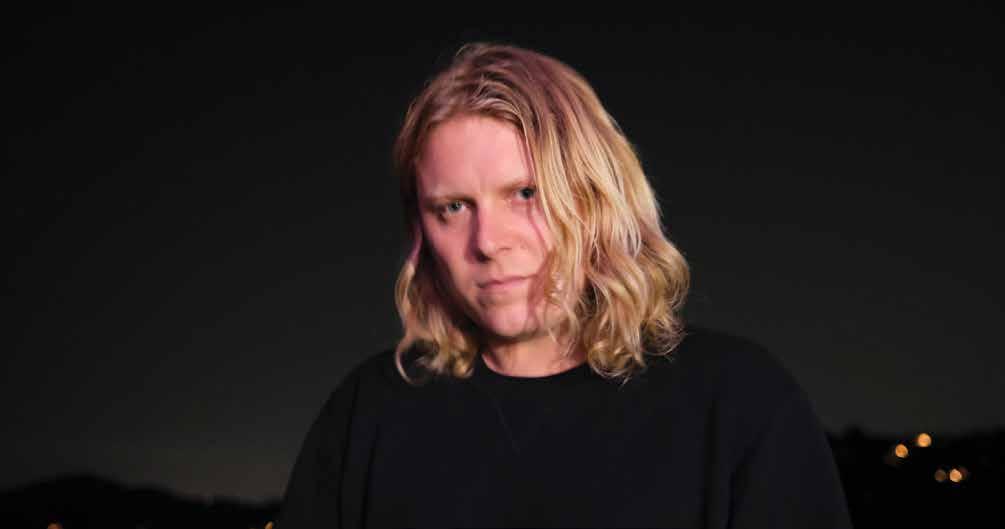



© Puzzles by Pappocom
Difficulty level: MEDIUM
There is really only one rule to Sudoku: Fill in the game board so that the numbers 1 through 9 occur exactly once in each row, column, and 3x3 box. The numbers can appear in any order and diagonals are not considered. Your initial game board will consist of several numbers that are already placed. Those numbers cannot be changed. Your goal is to fill in the empty squares following the simple rule above.

If you’re stumped, find the answer keys for these puzzles and archives of previous puzzles (and their solutions) at indyweek.com/puzzles-page or scan this QR code for a link. Best of luck, and have fun!
Edited by Patti Varol

Software Developer
Marvel Tech Groups Inc, has openings in Durham, NC. Software Developer ($ 94,515.00/Yr.): create, config, dvlp, Migrate & Dsgn, dvlp & implement app software. Reqs trvl to var unanticipated loc in the US for short- or long-term assignments. Standard Co. bnfts offered. Mail res & position to, Dir., Marvel Tech Groups Inc, 4819 Emperor Blvd, Ste. 400, Durham, NC, 27703 or email to hr@marveltechgroups.com. EOE.
Software Engineer II
Software Engineer II sought by LexisNexis USA in Raleigh, NC to play key role in team that builds/ tests CounselLink, which is enterprise software system that supports legal departments of some of the world’s largest businesses. Minimum of Bachelor’s degree or foreign equivalent in Computer Science, Computer Engineering, Information Systems, or rltd + 2 yrs exp in job offered or rltd occupations required. Employee reports to LexisNexis USA office in Raleigh, NC but may telecommute from any location within US. Interested candidates should apply via following link: https://relx.wd3.myworkdayjobs.com/relx/job/ Raleigh-NC/Software-Engineer-II_R92213.

Software Engineer II
Software Engineer II, F/T at Truist Bank (Raleigh, NC) Deliver technically complex solutions. Perform system integration support for all project work. Lead & participate in the dvlpmt, testing, implmtn, maintenance, & support of highly complex solutions in adherence to company standards, incl robust unit testing & support for subsequent release testing. Must have Bach’s deg in Comp Sci, Comp Engg, or related tech’l field. Must have 4 yrs of exp in s/ware engg or IT consulting positions performing/utilizing the following: applying in-depth knowl in info systems & ability to identify, apply, & implmt IT best practices; understanding of key business processes & competitive strategies related to the IT function; planning & managing projects & solve complex problems by applying best practices; applying broad functional knowl in defining technology reqmts; interpreting internal & external business challenges & implmtg best practices to improve products, processes, or services; & leading technology projects of moderate complexity. Utilizing exp w/: JCL, REXX, IBM Utilities, COBOL, DB2, CICS, VSAM, SQL, IBM Infosphere Optim, CA-ESP, CA-WA Workstation, File Manager, DBVisualizer, SoapUI, & RCQuery. Position may be eligible to work in a hybrid remote model & is based out of & reports to Truist offices in Raleigh, NC. Applicants must be able to work onsite at Truist offices in Raleigh, NC at least 3 days/wk. Apply online (https://careers.truist.com/) or email resume to: Paige.Whitesell@Truist.com. Ref Job: #R0100225.
Sous Chef
Sous Chef, Chapel Hill (Orange County) Ensure food and service quality. Coordinate cook’s tasks. Implement hygiene policies. Design new recipes, plan menus. Ensure appropriate staffing levels. Apply culinary trends and recipes. Hire and train kitchen staff. Perform administrative tasks. Monitor staff. Obtain customer feedback.
Requires at least two years of experience working as a Chef or Sous Chef in a Thai Restaurant.
Send resume to parawee.srisornsak@gmail.com. Thai Table NC, LLC.





